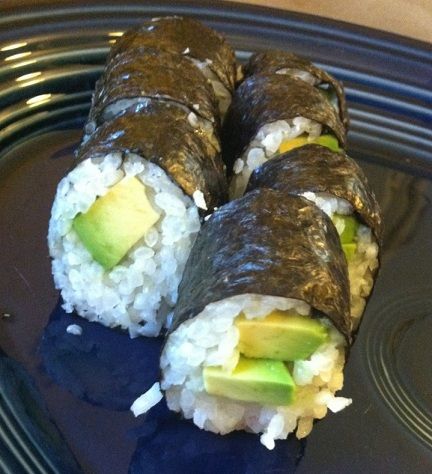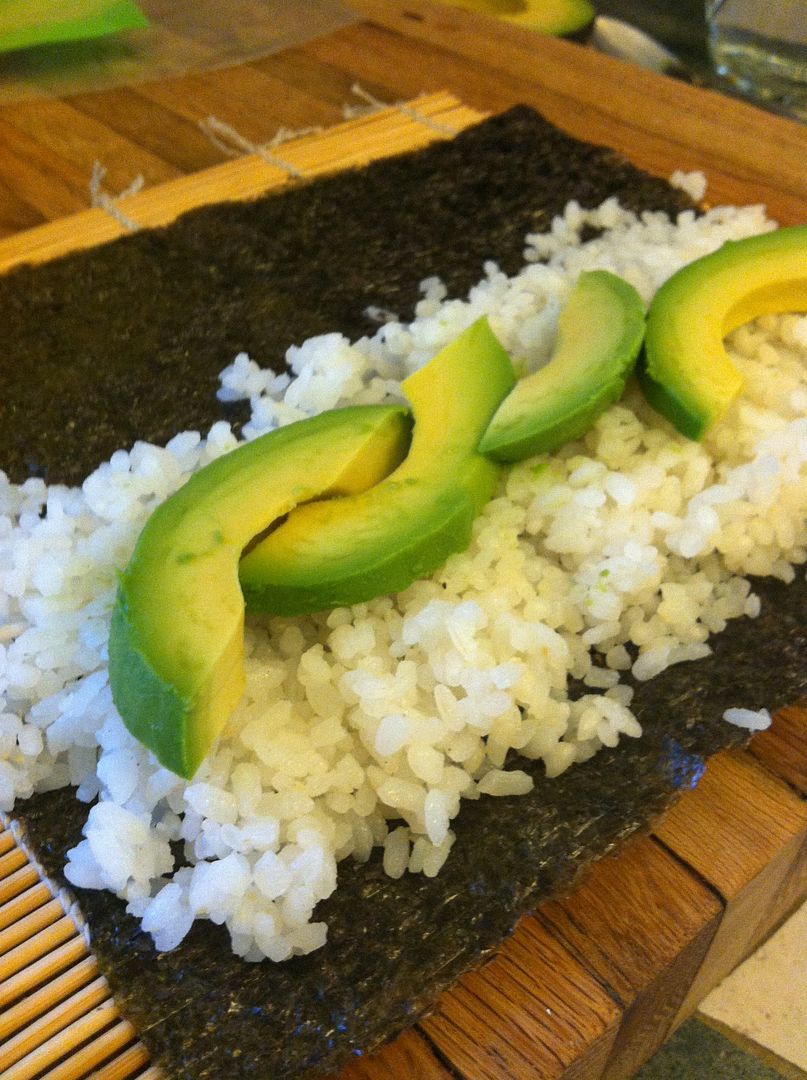
Some foods really lend themselves to cooking at home. Barbecue and soul food especially. And, on the other end of things, are the foods that are hardly ever cooked at home, and sushi may well be at the top of this list. But- it’s not impossible. And, in fact, with a little practice, it’s pretty straightforward.
I don’t pretend to be any sort of wonderful sushi chef. My rolls are very simple and sometimes they plain old look bad or don’t work. But the taste is wonderful. And if you’re in it for the taste, and you don’t want to drop a fairly significant bit of cash on a good sushi dinner, making it yourself is a gratifying option.
There are quite a number of instructions and videos on the internets, including an entire Alton Brown episode. Please check them out, especially if you’re a visual sort and a video will make some things clear.
So. To make sushi, there are a few things you’ll need:
- Most importantly is rice. Not just any rice, sushi rice is a short, stout, sticky grain. The word sushi loosely translates to vinegared rice- the rice makes it sushi.
- Nori, which is the sheets of dried seaweed in which sushi is wrapped.
- Rice vinegar.
- A wooden bowl (ideally).
- A very sharp knife.
- A sushi rolling mat.
- Whatever is going to be put in the roll.
- Soy sauce and wasabi, of course. I’ve accidentally bought what I thought was wasabi and been very disappointed. I get the S&B brand wasabi in a tube, which is quite nice.
These things are available in a handful of places in Little Rock, and I bet there are a few I don’t know about. Sam’s Oriental market and Mt. Fuji’s market are the obvious places. The Mt. Fuji market has a nice selection of sushi quality fish. Kroger in the Heights has nori and wasabi, but I could not find proper rice. Sushi makings and trappings is one of those areas where you could spend a lot of money if you wanted to. For example, a good sushi knife (called a yanagiba), like any good knife, can run upwards of $100. Plus an infinite number of tiny bowls and exotic ingredients. I sprang for a $35 Wasabi brand yanagiba knife, and I’ve been very pleased with it.
First, make the rice. I’ve been using Alton Brown’s recipe, which I think is quite good and not at all difficult. This requires:
- 2 cups sushi rice
- 2 cups water
- 2 tbsp rice vinegar
- 2 tbsp sugar
- 1 tbsp salt
The rice needs to be rinsed really, really well. Put it in a big bowl and place it under the tap and let water run into it. Agitate with your hand to speed this up. When the water is clear, it’s ready to boil. Put the rice and 2 cups of water in a pot with a tight fitting lid. Bring it to a boil uncovered, then put on the lid, turn it down to the lowest setting, and cook for 15 minutes. Then turn off the heat and wait 10 minutes.
While this is happening, prepare the vinegar, sugar, and salt. Combine all of them and heat it gently either in a bowl in the microwave or a tiny pot. Stir and heat until it’s mostly dissolved.

When the rice is finished, dump it into a wooden bowl. If you don’t have one, a ceramic or glass bowl will do. Pour the vinegar, salt, and sugar mixture over the rice. Then, using a rubber spatula, carefully divide and turn the rice over, being careful not to stir it. Cool the rice at the same time by fanning it with a paper plate or magazine or what have you. An electric fan or willing child or spouse will make this easier, if you have one handy. If not, you can alternate turning the rice over and fanning. Ninjas can possibly do both simultaneously, but I cannot. After a few minutes, it will have cooled enough that it is no longer steaming and is quite sticky. Now it’s ready to use. It should stay useful for a couple of hours, but I’ve never tested this.

And now comes the difficult part, at least for me. You’ll want your knife and a bowl or jar of water nearby, plus a towel for your hands. Take a cutting board, and place the rolling mat on it. Put down a sheet of nori. Then using the spatula, place rice evenly along the lower 1/2 to 2/3rds or so of the nori. Be sure the rice is even at the edges too, otherwise it will look more like a cigar than a roll. Place the ingredients on the rice. Dip your finger in the water, and run it along the far edge of the nori (so it will stick to the near edge). Then carefully pick up the near edge of the rolling mat and roll it up, ideally as tight as possible.
Writing the phrase, “then carefully pick up the near edge of the rolling mat and roll it up,” is basically my version of belling the cat. It’s not easy to get the rice in the proper amount and evenly, since it’s so sticky. Luckily some people will almost certainly be able to do it better than I. I make up for my lack of skill by using a whole sheet of nori. Regular rolls are usually half of a sheet of nori, but I can make a much prettier roll out of a whole sheet since there’s more room for error. It ends up looking more like futomaki (the big rolls) than an average roll.
Once rolled, take the roll out of the mat. Dip the very sharp knife into the water, and cut the roll in half. Then pair up the halves, dip the knife in water again, and cut them in half, and in half again. The water lets the knife slip through the nori — you’ll be able to feel when you need to wet the knife again. This is the easy part, and a few minutes of watching the sushi chef at Kroger will be more than enough to get acquainted with it. Cut each quarter roll in half on a diagonal, and it’ll look all fancy. Put it on a nice platter with soy sauce and wasabi, maybe run a line of sauce along the top, and eat it up.
There are of course dozens of things that can fill a roll. Avocado is my favorite. Crab stick, cream cheese, shredded carrot, and cucumber are also cheap and easily available. Quality fish is wonderful. And then of course there’s tobiko (roe), scallions, Sriracha sauce, spicy sauce made with Sriracha and Kewpie mayo, fried panko to make crunchy bits, and oodles more. Sushi lends itself to experimentation. The individual pieces can be battered and fried. The options are simply endless.
If rolling is too much work, or it’s going particularly poorly, it’s quite easy to make temaki, which is a hand roll. Place your rice and ingredients in a pile on one end of half a sheet of nori, with long pieces oriented diagonally, and roll it up so it resembles an ice cream cone. And of course you can make nigiri, which is the longish chunk of rice, with a slight smear of wasabi, and a piece of a sea creature on top. If you can find them, both kraken and leviathan are especially delectable.
Hopefully this will inspire people to give homemade sushi a shot. Don’t be afraid to mess it up — even ugly sushi tastes great. Good luck, and cook boldly!





